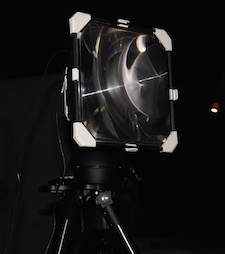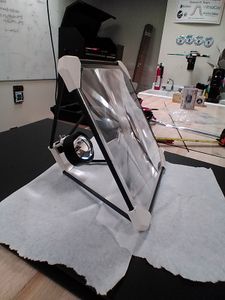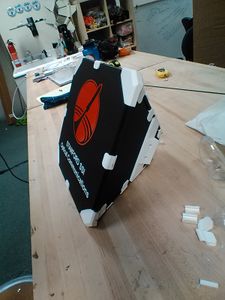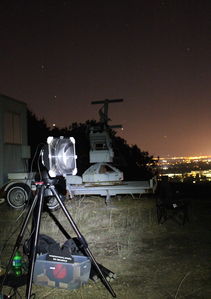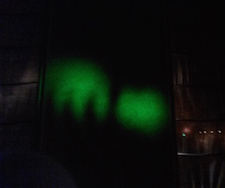Difference between revisions of "OpComms System IV"
Ehillstrom (talk | contribs) m |
Ehillstrom (talk | contribs) (linked to noise) |
||
| Line 7: | Line 7: | ||
The first two goals were addressed by purchasing a Fresnel lens with a slightly shorter focal length than the previous system, allowing the whole receiver to have a smaller depth, and by changing the format of the frame from a Duron (hardboard) cube to a pyramid structure composed of carbon fiber, plastic, and foamcore. The carbon fiber framing provides the structural element for Baby Black Box, ensuring that the thin Fresnel lens is not under any external loads and therefore will not deform. In addition, an effort was made to provide a mounting point calibrated to the center of mass of Baby Black Box, such that the torques were balanced about the axis of altitude rotation of the motorized mount. Due to the pyramidal shape, this resulted in a reduction of torque about the horizontal axis as well. | The first two goals were addressed by purchasing a Fresnel lens with a slightly shorter focal length than the previous system, allowing the whole receiver to have a smaller depth, and by changing the format of the frame from a Duron (hardboard) cube to a pyramid structure composed of carbon fiber, plastic, and foamcore. The carbon fiber framing provides the structural element for Baby Black Box, ensuring that the thin Fresnel lens is not under any external loads and therefore will not deform. In addition, an effort was made to provide a mounting point calibrated to the center of mass of Baby Black Box, such that the torques were balanced about the axis of altitude rotation of the motorized mount. Due to the pyramidal shape, this resulted in a reduction of torque about the horizontal axis as well. | ||
| − | The connections for Baby Black Box were 3D printed in ABS plastic. Corner mounting points set the angle between carbon fiber rods to precisely control the focal distance of the Fresnel lens, and snap connections secure the photodetector in place, as well as the foamcore sides and lens cap, which serve to protect the optics of the device and to screen out external light (noise). | + | The connections for Baby Black Box were 3D printed in ABS plastic. Corner mounting points set the angle between carbon fiber rods to precisely control the focal distance of the Fresnel lens, and snap connections secure the photodetector in place, as well as the foamcore sides and lens cap, which serve to protect the optics of the device and to screen out external light ([[Signal-to-noise ratio#Noise|noise]]). |
To address the third design goal, a secondary aspherical lens was purchased. An enclosure was created to fix this lens directly to the photodetector, with the intent that the focal calibration of this lens would be much less sensitive to misalignment from transport and handling. | To address the third design goal, a secondary aspherical lens was purchased. An enclosure was created to fix this lens directly to the photodetector, with the intent that the focal calibration of this lens would be much less sensitive to misalignment from transport and handling. | ||
Latest revision as of 20:21, 6 December 2015
OpComms System IV is the latest design iteration of the OpComms optical link, and is currently under development. This version features a redesigned Fresnel lens receiver, incorporating a secondary focusing optic and improved mechanical characteristics, and will include a complete code and control electronics overhaul.
Receiver System Update: Baby Black Box
The latest OpComms receiver system, named Baby Black Box, is an update of the older Fresnel lens receiver. The design goals for the update were three: (1) to decrease weight, so as to decrease strain on the motor, (2) complementarily, to decrease torque on the motor, particularly in the axis of altitude rotation, and (3) to more finely focus light into the photodetector system.
The first two goals were addressed by purchasing a Fresnel lens with a slightly shorter focal length than the previous system, allowing the whole receiver to have a smaller depth, and by changing the format of the frame from a Duron (hardboard) cube to a pyramid structure composed of carbon fiber, plastic, and foamcore. The carbon fiber framing provides the structural element for Baby Black Box, ensuring that the thin Fresnel lens is not under any external loads and therefore will not deform. In addition, an effort was made to provide a mounting point calibrated to the center of mass of Baby Black Box, such that the torques were balanced about the axis of altitude rotation of the motorized mount. Due to the pyramidal shape, this resulted in a reduction of torque about the horizontal axis as well.
The connections for Baby Black Box were 3D printed in ABS plastic. Corner mounting points set the angle between carbon fiber rods to precisely control the focal distance of the Fresnel lens, and snap connections secure the photodetector in place, as well as the foamcore sides and lens cap, which serve to protect the optics of the device and to screen out external light (noise).
To address the third design goal, a secondary aspherical lens was purchased. An enclosure was created to fix this lens directly to the photodetector, with the intent that the focal calibration of this lens would be much less sensitive to misalignment from transport and handling.
Further details of Baby Black Box can be found in the System IV Mechanical Design Log.
A preliminary 10km test with Baby Black Box at W6YX
New Laser Color: Red
A series of tests over 500m and 10km during Autumn quarter demonstrated an interesting and problematic phenomenon for the laser system: the beam seemed to arbitrarily switch between a normal operating mode and a mode which split into two fully separate spots. Experimentation revealed that this effect was thermally driven, an explanation confirmed by consulting the manufacturing specifications which listed a lower bound for the laser's operating temperature range that exactly matched the ambient temperature for the previous series of tests.
An attempt was made to build a heater system for the laser, but the team concluded that a better solution would be to switch to a laser of equivalent power output and class, but at the 635 nm wavelength (red). There were two reasons for the switch: first, that the red laser's range of acceptable operating temperatures included the typical set of ambient temperatures for OpComms tests, and second, that the team's existing photodetector [1] is slightly more sensitive to light at 635 nm than at either of the two previously tested colors (green, 532 nm, and blue, 450 nm).
Code Overhaul
The team is in the process of integrating all programming functionality into one interface. The new code system will be written in Python3 and interface directly with a Nucleo board to control motorized mount positions, alignment search algorithms, and data handling. The code overhaul will also feature an integrated Graphical User Interface that combines all functionality into one application.
Electronics Update
In parallel with the code update, the OpComms group is currently working to interface directly with the motorized altitude/azimuth mounts that control the orientations of both the transmitter and receiver. In addition, the new electronics system for the receiver will feature signal amplification and filtering.
